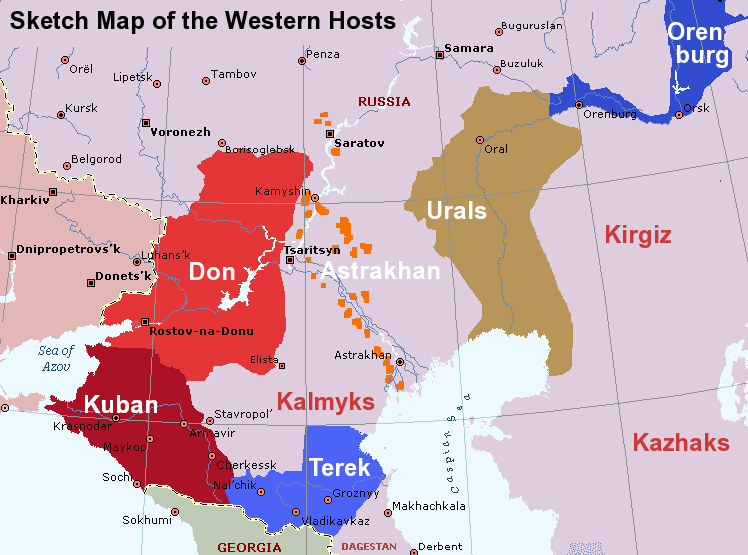
The Orenburg Host in the Russian Civil War
The Orenburg Host was settled along the upper course of the Urals River. It was the third largest host, after the Don and Kuban. Over the years it had absorbed large numbers of non-Russians into its ranks.
The Civil War started in the Orenburg lands, and until the collapse of Kolchak's forces in late 1919 it was criss-crossed by opposing forces Orenburg units were part of the retreating White forces until the very end.

Uniforms
The Urals Host soldiers wore standard Cossack dress, with their distinguishing colours being light blue.
Orenburg Cossack Cavalry
Ataman Dutov Divizion
Orenburg Infantry
Bashkirs
Other Units in the Orenburg Army
Information on the Orenburg Cossacks can also be found in Russian at kolchakiya.ru.
A Key Strategic Theatre
The Orenburg Cossacks were a key part of the anti-Bolshevik forces from the start to the end of the Civil War. They played a very similar role to that of the Don and Kuban Cossacks in the south, and like the Don their lands were a constant battlefield.
That the Orenburg lands bordered the major population centres of Siberia and the Emba oil fields, and were on the rail connection between Moscow and Turkestan, gave them a strategic importance that neighbouring Hosts never had. The early decisive unification of host command under Ataman Dutov also made them a major military force much earlier than most other Cossack hosts.
An outline of the Orenburg Host in the RCW
The Orenburg Army
Organisationally the Orenburg Cossacks alternated quite rapidly between more or less entirely local forces and groupings in which they were merged with other White forces. Because of this, and because they often supplied cavalry forces to their allies, Orenburg Cossacks were often seen fighting alongside non-Cossack forces, including KOMUCH, Czechs, Siberians, Kolchak's forces and other Cossack armies.
Most were cavalry, especially those serving outside the Host area. This gave the army mobility and ability to attack with surprise.
The Host's infantry was frequently non-Cossack in origin. It was backed up with insufficient support weapons, especially artillery but also machine-guns. Often the guns they did have were short of ammunition. Thus the Host was consistently outgunned by the opposition and so more or less unable to take fortified towns or to hold fixed positions.
Lack of direct transport access to other fronts meant that the Host had no armoured cars, only a few improvised armoured trains and few planes, though fuel was at least available.